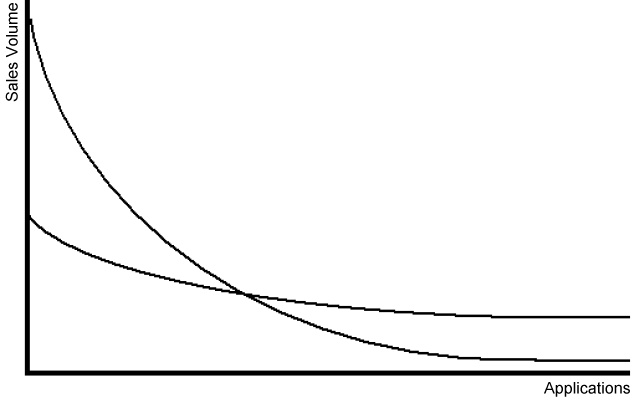Congratulations to the developer, but as the author of the piece rightly points out via Twitter, “I've read far too many articles about devs pouring hundreds of man hours into an app and selling less than a few hundred copies.”
The success stories of App Stores are easy to find, but finding an app store that consistently provides an income for even a significant portion of developers (as opposed to a regular stream of money for a nice meal at the end of the month) is proving to be a little trickier.
Having a huge volume of applications makes an App Store attractive to the casual user – if there are x thousands of applications then it must be a good phone for me to buy, goes the thinking in the marketing department. But of course the chances of the developer being able to make a good living without a huge stroke of luck from those running the store is very small.

Coding, by Kaptian Kobold, via Flickr.
I’m not sure what would be a better ecosystem: one with thousands of applications that earn their developers up to £400 a month, or one with hundreds of applications which allows the developers to work on the apps for a full time wage. While the latter store would probably be a bit more successful for the developers, in terms of marketing and attractiveness, it would be laughed out of the 2010 town for being far too small.
Yes, the quality of the application has to play a part in any success, but sometimes a good application is not enough.
App Stores by their nature have a lot of applications – far more than can appear on two or three screens on a mobile – by the third screen, I think the average user will no longer want to keep scrolling – so the curation of the apps by the recommendation engine becomes a critical component of the app store process.
No matter what is tweaked, there will always be a curve, with the most popular apps bringing in the most money. In a perfect world, to attract more developers, you want to keep the curve as flat as possible. In my mind, it’s far better to have 20 developers on a living wage rather than one developer earning millions and everyone else able to get a single extra beer each week. That’s an exaggeration of the position, but hopefully you see the idea - to lift the single beers further up the income charts.

And here is the challenge going forward. As you attract developers, you are going to want to keep them working on your platform. The simple way to do that is to ensure that they can make money, and continue to earn money. A well thought out App Store, with good navigation, that spreads as much promotion around while still having sensible search options and filters is a requirement, and I don’t think any of the major app stores currently available on handsets are up to that task.
While a communistic system of “sharing all the users and their money out equally” is just as mad as “the big warehouse the users just walk round randomly” idea of a pure capitalistic app store (which is only one step removed from what we have at the moment), the goal of making sure that more applications have more visibility to more users is not only a worthy goal, but one that will be vital to the success of any ecosystem in 2010 and beyond.
-- Ewan Spence, March 2010.
